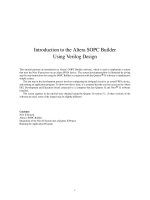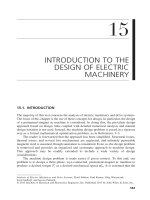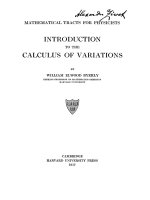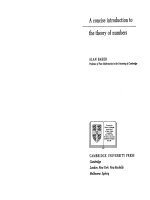Letharby architecture and introduction to the history and theory of the art of building docx
Bạn đang xem bản rút gọn của tài liệu. Xem và tải ngay bản đầy đủ của tài liệu tại đây (18.82 MB, 266 trang )
W.
R.
LETHAjfiY
AN
INTRODUCTION
TO
THE
HISTORY
AND
THEORY
OF
THE.'AHI
OF
BUILDING
720.9
Architecture
61-17UO
ARCHITECTURE
i.
i?^
Oxford
University
Press,
Amen
House,
London
E.C.4
GLASGOW NEW
YORK
TORONTO MELBOUBNE WELLINGTON
BOMBAY
CALCUTTA
MADRAS
KARACHI CAPE TOWN LBADAN
Geoffrey
Cumkrlege,
Publisher
to
the
University
WILLIAM
RICHARD
LETHABY
C.
W. R.
LETHABY
ARCHITECTURE
An Introduction
to the
History
and
Theory
of
the Art
of
Building
With
a
new
Preface
and
Epilogue
by
BASIL
WARD,
F.R.I.B.A.
Lethaby
Professor
of
Architecture
at the
Royal College of
Art,
London
GEOFFREY
CUMBERLEGE
OXFORD
UNIVERSITY
PRESS
LONDON
NEW
YORK
TORONTO
1955
First
published
in
the
Home
University
Library
in
1911
and
re-
printed
in
1919,
1924,
1925,
and
1927.
Second
edition
1929,
reprinted
in
1930,
1935.
wt
*937-
Third
edition
with
new
Preface
and
Epilogue
by
Basil
Ward,
and
plates,
1955-
Primed
in
Great
Britain
by
Butler & Tanner
Ltd.,
Frome and London
Contents
PREFACE
BY BASIL
WARD
ix
w.
R. LETHABY'S
PRINCIPAL LITERARY
WORKS
xxix
I
ARCHAEOLOGY,
ARCHITECTURE,
AND
ORNAMENT
I
/
II
ORIGINS
OF
ARCHITECTURE
9
[II EGYPTIAN
MONUMENTS
22
IV EGYPTIAN
BUILDING
METHODS
AND
IDEAS
37
V
BABYLONIA
AND CRETE
EARLY
ART
IN
ASIA
AND
EUROPE
'
4-8
VI
BUILDING
ART IN
GREECE
THE
EFFORT
AFTER
PERFECTION
5^
VII
HELLENISTIC
AND
ROMAN
ARTS
EN-
GINEERING
BUILDING
80
VIII
EARLY
CHRISTIAN
AND
BYZANTINE
SCHOOLS
A NEW
DEPARTURE
100
IX
THE
EASTERN
CYCLE
120
X
ROMANESQUE
ART
NEW
BLOOD
IN
ARCHITECTURE
130
VI
CONTENTS
XI SAXON AND NORMAN SCHOOLS
141
XH
.GOTHIC
BUILDING
IN
FRANCE THE
ARCHITECTURE
OF ENERGY
154
XHI
ENGLISH GOTHIC
163
XIV
THE
RENAISSANCE
ARCHITECTURE OF
RHETORIC
AND
ARCHITECTURE OF
FIRST
PRINCIPLES
177
XV
THE
MODERN
POSITION
183
EPILOGUE
BY
BASIL WARD
Ip5
PLATES
following
p.
214
INDEX
215
Illustrations
WILLIAM
RICHARD
LETHABY
*
.
Frontispiece
Portrait
bust,
c.
1900,
by
unidentified
sculptor.
Photo-
graph
in
the
possession
of
Mr.
A.
Llewellyn
Smith,
M.B.E.,
M.A.,
F.R.LB.A.
The
present
location
of the actual
bust
has
not
been traced. It
is a
good
example
of
the
best work
of
the
period,
and is
an
excellent
portrait
judged
by
contemporary
photographs
of
Lethaby.
Between
pages
214
and
215
Plate
I
THE
EAGLE
INSURANCE
COMPANY'S
BUILDING,
BIRM-
INGHAM,
1900,
by
W. R.
Lethaby
and
J.
L.
Bell
Drawing
from
Royal
Institute
of
British Architects.
Illustra-
tions of this
building
were
published
contemporaneously
on the
Continent.
The
building
shows no
trace of
art
nouveau influence.
Although
there
are
traditional
features
with
pilasters
and
entablatures,
also
traces of
the influence
of
Philip
Webb
and
Norman
Shaw,
there is
a
marked
air
of
originality
in the
design.
There is also
modernity
in
the
attention
given
to
good day-lighting
through
the
use of
large
windows.
n
ALL
SAINTS'
CHURCH,
BROCKHAMPTON,
HEREFORD-
SHIRE,
by
W.
R.
Lethaby
Photographs
by
Royal
College
of
Art.
Although
traditional
in
form,
the
design
has
a freshness
seldom encountered
in
architecture of
the
turn of
the
century.
The
main
structure
of
the"roof is
in
concrete.
There was
an
attempt
to
use
central
heating,
and
the furniture
and
fittings
were
specially
designed
by
members of the
Arts
and
Crafts
Movement.
Viii
ILLUSTRATIONS
Plate
m
SIDEBOARD
designed
by
W.
R.
Lethaby
Now in
the
Victoria
and
Albert
Museum,
London.
WORKING
DRAWING
FOR
DRAWER
FRONTS
OF WOOD
INLAY
by
W.
R.
Lethaby
IV
SKETCHES
FROM
NOTEBOOKS
OF
W. R.
LETHABY
The
drawings
ofthe horses
are
minute.
By
kind
permission
of
the
North
Devon
Athenaeum
t
Barnstaple.
V WATER
COLOURS
AND
A
PEN
DRAWING
by
W.
R.
Lethaby
By
kind
permission
of
the
Royal
Institute
of
British
Architects.
vi
DRAWINGS
FOR SILVER
WARE
by
W.
R.
Lethaby
when
aged
twenty-five
He
won
prizes
in
the
Goldsmiths'
Hall
Competition,
and
the
prize
money
enabled him
to travel on the Continent.
Drawings
in
the
possession of
Mr.
A.
Llewellyn
Smith,
M.BJ3L,
MA,
F.RJ.B.A.
VH
MAIN
RAILWAY
TERMINUS,
ROME
Architects:
Montuori
and
Associates.
THE
LEVER
BUILDING,
NEW
YORK
Architects:
Skidmore,
Owings
and Merrill.
UNITED
NATIONS
BUILDING,
NEW YORK
Architects:
Wallace
K. Harrison
and
Associates.
Vm
MINISTRY
OF
EDUCATION
AND
HEALTH,
RIO DE
JANEIRO
Architects:
L. Costa
and
Associates.
LAKE SHORE DRIVE
APARTMENT,
CHICAGO
Architects:
Mies van de
Robe
and
Associates.
L'UNITE
D'HABITATION,
MARSEILLES
Architect: Le
Corbusier.
Lethaby
showed remarkable
prescience
concerning
what
was to come. In thelast
chapter
ofArchitecture he writes on
the
'modern
position*,
and
in
the
Epilogue
to this
edition
his views
are discussed
in the
light
of
following
events.
The illustrations on Plates
VII
and
VIII show architecture
which is
the outcome of the
use of
modern material
and
forms
of
structure.
They
are
outstanding
examples
of
the
architecture that
has
developed
since
Lethaby's
time.
Preface
THIS
new
edition of
Architecture
will
help
to
absolve
us
from
treating
W. R.
Lethaby
as
a
'prophet
in
his
own
land'.
Modern
times
must
surely
be
remarkable
for
rapid
growth
and wide
extent of
building
and
engineering
de-
velopment
and for mass
production
of
things
of
everyday
use.
History
will
record
the
achievements.
But
the
times
are
also remarkable for
a
general
low level
in
standards
of
aesthetic
quality
in
architecture
and
in
many
branches of
industrial
design,
and
for
prevalence
of
a
philistine
atti-
tude
throughout
the
community.
The level in standards
was low
andphilistinism
was
rife at the turn
of
the
century
when
Lethaby
was
active
in fields of
art,
yet
he made
positive
and
original
contributions
to
architecture
and
design.
He
was
one of
only
a
few
who did so and
whose
work
will,
as is now
coming
to be
realized,
endure
in his-
tory
and
be
recognized
as
in
the
best
tradition
of
Euro-
pean
architecture
and
of
production
of
artefacts.
But
more
than
this,
Lethaby
contributed,
by
writing
and
teaching,
with
criticism,
with
a
reaffirmation of
first
principles
also
with
revolutionary
ideas,
at
a time when
there
was
great
need
of such
things.
Architecture
is
a
popular
book
and as such
it
is one
ofthe
best
of
its
kind.
The references
in
it
to
the
civilizations from
X
PREFACE
which
sprang
the
great
art
styles
may
be
too
summary
for the
expert,
but
Lethaby
drew
attention in
popular
language
to
the
fact that architecture is but one
element
in social
cultures,
the
overall
configurations
of
which
shift
and
alter,
and he
wrote:
*A
small
book,
which
does
not
permit
of
dealing
with
individual
buildings,
might
better
suggest
the
onrush
of
perpetually
changing
art
which,
while
we
try
to
grasp
it,
has
already
put
on another
form'.
Then
again,
'Only
by searching
out
origins
can we
dis-
cover
the initial
force
which
carried
art
forward.
In the
main
we find
two
great
factors,
response
to
need
the
basis
in
utility
and,
secondly,
a
magical
and
mystical
element.'
. ; . 'The
magical
instinct,
in
seeking
to re-
create
types
and to
set
up
sympathetic
relations,
led to
imitation,
to
ideas
of
proportion,
and to
a
search
after
perfection.'
These
extracts
give
an idea of
the
tone and
substance
of
a
book which
has
been
of
great
help
and in-
spiration
to
a
wide
public
and
is
treasured
by
architects old
and
young
alike.
It
is
not
ponderous
nor is
it
precise,
and
it is not
perhaps altogether
exact,
but
making
allowances
forfashion in
languageand
putting
aside
certain
subjective
passages arising
from
the author's
own
very
human
preju-
dices,
it is
a
valuable
book,
for
it throws
a
bright
light
on
the
past,
shows
that
the
author
had
few
illusions
about
his
own
times,
and
was,
and
one
may
believe
still
is,
remark-
ably
prophetic
about the
future.
The
final
paragraph
of
the book
might
indeed
have
been written
by
our
modern
prophet
of the
Western
world,
Le
Corbusier.
William
Richard
Lethaby
had
unusual
attributes of
character
and
his
mind
ranged
far
and
wide.
Of
the
many
people
alive
today
who
knew
him,
all,
we can be
sure,
PREFACE
would
speak
of
personal
qualities
rare in
modern
times.
His
life
was
one
of
humility
and
of
utter
want
of
self-
seeking.
He
was
highly
regarded
for
these
qualities
when
he
was
alive
and
it
is
known
that
he
would
not
allow
his
name
to
go
forward
for
honours
and
distinctions
such
as
the
community
bestows,
sometimes
rightly,
and
some-
times
to
its
credit,
upon
outstanding
men.
From a
study
of
his
work
and
of
what
he
taught,
it
would
appear
that
his
nature
allowed
him
to
perceive
what
so
very
few of
us
see
for
ourselves,
something
expressed
time
and
again
in
his
writings
and
lectures
and
summed
up
in
his
aphorism:
'Old
art
was
circumscribed
and
conditional,
now
we
might
do
anything,
only
we
can't.'
He
understood
that
in
a
society
based
on the
quantitative,
representative
man
in
surrendering
to
quantity
had
become
unduly
ex-
trovert,
and
had
largely
forgotten
his
own
mind
and
spirit,
so
the
great
integrating
inheritance
of
Christianity
began
to
fade
and
national
power
politics
and
the
personal
ambitions of
the
"entrepreneur**
increasingly
dominated
the social
scene/
*
Clearly,
there
are
deep
psychological
considerations
as
well
as
significant
socio-histoMcal
events
to
be
taken
into
account in
studying
human
character
and
behaviour,
but
it
must at
once
be
said of
Lethaby
that
he
was an
out-
standing
figure
in
his
own
times:
not,
however,
an
his-
torical
figure,
a
public
or
an
eccentric
figure,
but
one
who
made
a
difference.
Several
important
accounts
of
the
period
mention
either
his
name
or
the
movements
in
which
he is
known to
have
been
active,
and
references to
1
L. L.
Whyte,
contributing
in
Ideas
and
Beliefs of
the
Victorians.
London,
1949,
p.
240.
Xii
PREFACE
him
continue
to
crop
up.
It can
truly
be
said
that he
had
qualities
of
real
humility
and
innate
modesty, qualities
which,
combined
with
natural
simplicity,
tend
generally
to
make
less
of
an
impression
in
the
community
in the
Western
world
at least
than
do
those
of
a
more extro-
vert
and
combative
nature.
Yet
it would
be
wrong
to
confuse
Lethaby's
characteristics
with
meekness,
or
with
ingenuousness
in
the
affairs
of
man.
It
is
easy
to
appreciate
simplicity
some
are
derisive
about
it,
but
simplicity
is
not
easy
to fathom.
He was
tenacious
in
pursuit
of
his
aims,
forthright
in
expressing
his
views,
and
he
made
strong
personal
impressions,
perhaps
not
always agreeable
though
it
would
have
distressed
him
to know
this
upon
everyone
with
whom
he came
into contact. He
greatly
influenced
his
contemporaries:
men
as
different
in
taste,
in
temperament,
and
in their
activities
as
socially
successful
Royal
Academician
architects
and
simple-life
handcraftsmen;
also
he
influenced
thought
in
a
variety
of
fields outside
architecture
and
the
fine
and
applied
arts.
Lethaby
said,
'Every generation
stains
its
own
children
its own
colour',
which
the
social-anthropologist
would
confirm.
At
the
ages
between
thirty
and
forty
and in
the
fin
de silde,
decade,
when
he
was
most
active in
architec-
ture,
when he was
filling
many
note-books
on his
travels
in
England
and
abroad,
and when
he was
formulating
his
main
ideas,
signs
of the influences
of his
early years
can
clearly
be seen the
nonconformist,
radical influences
of
the
third
quarter
of the
nineteenth
century
and the influ-
ences characteristic of
the social
class
into which
he
was
born,
the class
emerging
from the artisan
to the middle
PREFACE
Xiii
class.
Furthermore,
as
a
youth,
he had
entered
architecture,
having
shown
a
talent
for
art,
an
attribute
which,
though
considered
perhaps
not
altogether
respectable,
could
lead
to
occupations
which
in
the
times
just
gone
by
had
been
open
only
to
a
relatively
select
few,
generally
fiom
amongst
or
closely
attached
by
custom
to
the
'enjoying
classes'.
Could
there
have
been
more
promising
soil
than
in
all
this for
the
growth
of
Ruskinian
ideas
on
art
and
Ruskinian
inspirations
on
social
and
economic
matters?
1
quite
early
found
Ruskin
for
myself,
full
fifty
years
ago',
said
Lethaby
at
the
age
of
sixty-five.
1
We
know
that
Ruskin's
influence
upon
aspiring
social
classes,
people
for
whom
Fors
Clavigera
was
written,
was
tremendous,
and
that
the
outcome
of
it
was in
some
re-
spects
later
regretted
by
Ruskin.
Lethaby
must
have
been
influenced
by
what
was
commonly
felt
he
was
by
no
means
the
only
youth
to
find
Ruskin
for
himself.
But,
a
gifted
boy,
with
considerable
insight,
he
probably
bene-
fited
from
good
rather
than
from
any
bad in
Ruskin's
teachings,
and
no
doubt
the
discipline
of
his
upbringing
and
his
environment
helped
to
offset
the
headiness of
the
great
critic's
ideas.
Later in
life
he
defended
Ruskin
and
wrote: 'A
prophet,
however much
he
may appear
to
be
in
opposition
to
his
age, yet
in a
peculiar
way
represents
that
particular
time.
He
is
the
antidote,
the
balance,
the
complement,
and his
is the
voice
which
awakes
all
those
who
are
ready
to be
like
minded.
If
he is
wholly
success-
ful,
and
his
teaching
is
absorbed,
it
may
afterwards
hardly
be understood
how
anyone
might
ever
have believed
1
Address
to
William Richard
Lethaby
with his
Reply,
18
January
ig22.
Oxford
University
Press,
p.
n.
XIV
PREFACE
otherwise.
The
flashing
inspiration
becomes
a
common-
place.
It
is
the
prophet's
aim to
be
thus
abolished,
to be
lost
by
diffusion/
1
In
Architecture there
is an
interesting
comment on
Rus-
kin's
Seven
Lamps of
Architecture. It draws
attention
to
Ruskin's own
realization of the limitations of his
great
book,
by
quoting
the
note
in a
later edition:
'.
.
.
there
is
too
much
stress
laid
throughout
this
volume in
probity
on
picturesque
treatment,
and not
enough
in
probity
on
material
construction.'
It
would
indeed
be difficult
to
say
who
was
truly repre-
sentative
of
the
period
Lethaby's
most
active the ten
years
before and
the fifteen
years following
the end of
the
last
century,
a
period
of
tremendous
personalities
and
revolutionary
intellectual and social
movements,
kaleido-
scopic changes
in
taste,
ideas,
and
behaviour.
Lethaby's
conscious
acceptance
of
being
a child
ofhis
culture,
of
his
generation,
taken
together
with his
prophetic
writing,
examples
of which
are in
the
opening
and
closing
chap-
ters
of
this
book,
may certainly
cause us to
think of him
as
a
man
whose
responses
were not
normal
to
his
period,
as
a
figure
standing apart
from
his
fellows.
Attempts
to write
about
Lethaby
and his work
have
sometimes failed or
not
gone
far
enough
to
get
at
the
truth.
He
has
been
labelled
'moralist',
and he
has
been
thought
of
as
rather
finicky
and
self-contained,
a
socialist
and
a
romantic,
whereas
the
evidence
of
his
writings
and
works
of
architecture
and
design
suggest
such
interpreta-
tions
to
be
shallow.
Confusion
arises
perhaps
because,
1
W.
R.
Lethaby,
Form
in
Civilization,
Collected
Papers
on Art
and
Labour.
London,
ed.
1936,
p.
183.
PREFACE
XV
since his
day,
there
has
been a
strong
reaction
against
Ruskinian
and
Morris-like
art-philosophers,
with
their
'art
for
life's
sake'.
As
Sir
Kenneth
Clark
says,
since
Geof-
frey
Scott's
Architecture
of
Humanism in
1914,
*.
.
.
a
belief
in
the
amorality
of
art,
the
isolation of
aesthetic
experi-
ence,
has
taken
root
in
the
fashionable
mind .
. .'
3L
How-
ever,
Geoffrey
Scott's
seminal
book,
while it
demolishes
the
ethical
fallacy
in
the
criticism
of art
and
architecture,
nevertheless
takes
up
the
question
of
morality:
'Morality
deepens
the
content
of
architectural
experience.
But
archi-
tecture
in its
turn
can
extend
the
scope
of
our
morality',
and
Scott
concludes that
civilized
and
human
values
play
their
part.
With
Lethaby
a
perhaps
more
valid
assumption
is
that
he
was a
protagonist
of
the
idea,
so
ably
discussed
by
Ber-
nard
Berenson,
that art
is
'life-enhancing'.
Also,
that
he
believed
in a
regeneration
of
humanist
principles
and
values
regeneration
in
the
sense
of
creating
anew,
be-
cause,
as
would
perhaps
be
natural
with his
background
and
early
influences,
he
distrusted the
'aristocratic'
human-
ism
that
had
grown
out
of
the
Renaissance. And
this
new
idea
of
humanism
had in
it a
touch
of
Maurice and
Kings-
ley's
Christian
Socialism,
Ruskin's
Guild
of
St.
George,
William
Morris
Arts and
Crafts
socialism,
and
Webb
and
Shaw
Fabianism.
And
do we
not also
see
it as
part
of
the
ethos of
the
time,
the
questing spirit
of a
period
notable
for
its
'movements' and
experiments?
In
European
antiquity,
humanism
worked in
man to
offset
the
seeming
chaos of
the
cosmos.
It
expressed
itself
1
Sir
Kenneth
Clark,
The
Gothic
Revival
(London,
1928.)
New
York,
1929,
p.
294.
XVI
PREFACE
through
a
sense
of
community,
in
self-contained
City-
states
in Greece
and
in
Imperialism
in Rome: an
imperial-
ism
based
on
the
concept
that
everyone
and
every place
un-Roman
was
barbarian;
also
it showed itself in
Greek
and Roman
sculpture
and
architecture:
in
slow-to-change
order
and
rule,
denial
of
space,
'static'
form, balance,
sym-
metry,
and
calm.
In
Gothic
times,
man
relied
upon
the
concept
of
religion,
and
with
this
his
own
position
in
nature,
and
his
freedom,
became
less
relevant;
there
is
an
ecstatic,
out-of-this-world,
quality
in
his
art;
and as
long
as
the
medieval
concept
remained
mysterious
and inco-
herent
infinite,
not forced
too
far
along
paths
of
useless
logic
into
the
maze
of
Scholasticism
Gothic
man's
archi-
tectural
expression
of it
led to
production
of
'dynamic'
Form,
to dramatization of
Space,
to
daring
in
construc-
tion,
resplendent
beauty
in
buildings,
and
exquisite
crafts-
manship
in artefacts. Renaissance
man,
rebelling
against
the
inhumanity
of
the medieval
and the
restraints
and
dogmas
of
Scholasticism,
seeking
to
re-identify
himself
as in the centre of
things,
turned
to
antique
humanism,
because
it
seemed
to
signify
human
rather
than
inhuman
order.
In the
same
spirit
he
turned,
in
architecture,
to
the
ruins
about him
exteriorized
symbols
of
ancient
times;
for,
of
course,
it was
in
a
renascent
Italy
that
the
originat-
ing
Renaissance force
was
seen.
Within the
new
human-
istic
order,
freedom
and
individuality
seemed
to
have been
gained;
within
it,
and
the
antique
architectural
Orders,
there
was
manifested
one
of
the most
daring
creative
architectural
excursions
into
the sublime ever made
by
man. At first
tentative,
eventually
becoming
more
assured,
it
thrust out
against
the
circumscribed frontiers of
classical
PREFACE
order
witk
hectic
and
fantastic
spirit
in
Roman
Baroque
then
lost
its
impetus,
except
for
reanimation in
Western
European
Baroque,
in
which
must
be
included
English.
It
came to
an
end
of
grace
and
beauty
in
the
English
Georgian,
but
faint
echoes
of
its
power
and
greatness
re-
turned
with
individualistic
nineteenth-century
classical
revivalism,
in
the
twentieth-century
architecture of
Lut-
yens,
and,
with
fainter
echoes
still,
in
the
neo-Georgian
of
the
twenties
and
thirties
of
our
own
century.
The
Renaissance
was a
period
of
the
*
whole
man*,
ex-
emplified
by
Masters
in
whom
was a
synthesis
of
science,
engineering,
and
art
the
greatest
master
in our
own
his-
tory
being
Wren.
In
painting,
the
invention of
perspec-
tive
suggests
the
growth
of
importance
attached to
the
human
individual
and
rational
viewpoint.
Philosophy
and
engineering,
no
longer
tied
to
narrow
medieval
concepts,
sought
new
and
wider
fields.
Although
the
period
is
not
distinguished
for
inventiveness
in
constructional
ideas
or
development
of
new
materials
in
building,
it
is
so
for
daring
in
the use
of
known
forms,
for
example,
the
dome.
And
in
mechanical
engineering
and
physical
science,
modern
ideas
owe
much
to
Renaissance
speculations
and
experiments.
Lethaby,
in this
book,
suggests
that
"modern
engineering'
was
'the
noblest
architectural
result of
the
Renaissance'.
However,
under
the
sway
of
humanism and
the
classical
order,
the
cult
of
individuality
grew.
In
the
Renaissance
were
the
seeds of
modern
individualism.
The ancient
idea
that
freedom and
necessity
are
one
was
to be
forgotten,
and freedom
was to
be
understood as
individual
licence
and
indiscipline.
In our
own
society,
'neither
so
brilliant
XViil
PREFACE
above
nor stable
below'
as
the
eighteenth
century,
we
have
suffered
greatly
from,
new
conceptions
of
freedom
and
individuality
balance-of-power
politics
and states-
manship,
totalitarianisms,
stratified
social
cultures,
the
schism between
art and science.
Nevertheless,
we
have
benefited
much
from the
radicalism,
reforms
and
humani-
tarianism of
middle-class
men
foremost
in the nineteenth
century-
men of
letters,
scientists, artists,
engineers
but
for the ideas
and work
of
whom
concepts
of
freedom
would
not have become
finite and
coherent
in
the
shape
of
civilizing
reforms.
In
Architecture,
Lethaby
gives
only
six
pages
to
the
Renaissance
but
they
are
curiously
interesting
pages.
He
shows
a
Ruskinian
dislike
and distrust
of
Renaissance
architecture
and
makes
subjective
comparisons
between
it
and
Gothic.
Geoflrey
Scott is
critical of these
compari-
sons
and
quotes
Lethaby
as
saying
in Architecture: 'It
must,
I
think,
be admitted
by
those
who
have in
part
understood
the
primary
styles,
Greek
or
Gothic,
that the
Renaissance
is a
style
of
boredom.
.
.
. Gothic
art
witnesses
to
a
nation
in
training,
hunters,
craftsmen, athletes;
the Renaissance
is
the
art
of
scholars,
courtiers
. .
/
Incidentally,
Scott
does not take
the
quotation
to the end
of
the
sentence
which
reads,
.
.
. and
the
connoisseurship
of
middle-
men'.
1
No
doubt
it
is the
logic
of
Scott's
position
in
dealing
with
the Romantic
Fallacy
that
leads him
to
pro-
nounce
strictures
on
Lethaby.
'When
a
critic',
Scott
notes,
'perhaps
as
learned and
as
eminent as
any
now
writing
on
the
subject
of
architecture
in
England
can
offer
us
these
censures,
even in
a
popular
work,
as
though
they
were
1
See
p.
180.
PREFACE
XIX
accepted
commonplaces,
it
is
not
easy
to
hope
that
the
Romantic
Fallacy
is
becoming
extinct.'
l
But
in
the
light
of
our
times
it
might
be
thought
that
Scott did
not
alto-
gether
understand
Lethaby.
It
was
Lethaby's
nature
to
look
upon
things
from
a
social
and
personal
point
of
view.
Also,
Scott,
first
and
foremost
a
scholar
and
a
critic,
was
a
great
protagonist
for
Reason
and
Humanism
and
wrote
at
a
time
of
reaction
against
nineteenth-century
ideas
which
were
already
becoming
a
legend
and
thought
of
by
some
as
romantic.
Lethaby,
a
practising
architect,
designer,
and
teacher,
had
more
than
the
ordinary
scholar-
ship
but
he
was
not a
scholar in
the
strict
sense
of
the
word;
and
he
was
not
a
philosopher
using logical
methods
and
bringing
proof
in
pursuance
of
his
ends.
Psychologic-
ally,
his
was
an
immediate
reaction,
he
had
penetrating
vision
and
came
to
conclusions
on
cause and
effect
sooner
and
sometimes
(it
would
seem)
with
less
justification
than
would
many
other
types
of
men; but,
as
it
has
been
with
similarly gifted
seers,
his
conclusions
were
often as
right.
He
had
great
diligence
in
study,
sought
knowledge
in
a
great
variety
of
fields,
and
had
a
power
of
analysis
that
reached
its
greatest
height
when
directly
applied
to
visible
things,
of
which
he
was
always
vividly
conscious,
particu-
larly
as
to their
beauty
or
their
ugliness.
As
already
noted,
it
was,
above
all,
his
nature
to
look
upon
things
from a
social and
personal
point
of
view.
For
him art
was
not a
special
way
of
doing particular
things
but
a
way
of
doing
everything
&
way
of
life.
Not
only
was
he
influenced
by
Ruskin
and
Morris,
but in
the
way
they
were
alike
in
1
Geof&ey
Scott,
The
Architecture
of
Humanism.
London,
1947
(first
pub.
1914),
p-
58
n.
(i).
XX
PREFACE
personality,
as
indeed
they
are
said
to
have
been,
1
his
personality
was
like
theirs.
The
points
of
view of Ruskin
and of
Morris are
nowadays
better
understood,
as is
their
significance,
and
we
have
cause
to be
grateful
to
men
like
Lethaby
whose life-work
has in some
part
been
an
interpretation
of the
purpose
of
those
remarkable
teachers.
It should
be stressed
that
Lethaby
was
a
practising
archi-
tect
and
designer.
Like
Philip
Webb,
whom he
admired,
he
tried
hard
to work
on
a
'basis
of
utility'
and,
also like
Webb,
he
was
greatly
successful
in
doing
so.
None
of his
works
are
conventional,
none
mere derivatives
from
the
academic
styles,
all
avoid
the esoteric
language
of the art
nouveau
movement
strong
and with
widespread
influ-
ence
in his time and
though
in
design
his
buildings
have
some
of the mannerisms
of Norman
Shaw,
Philip
Webb,
and
others of
that
school,
they
have
a
down-to-earth
quality
that
comes
from talent for architectural
compo-
sition
and from the
ability
to
appreciate
human
needs.
Yet,
throughout
all
his architecture
and
his
design,
he
'snatched
a
grace
beyond
the
reach of art'.
This
may
be
felt
in a visit
to
All Saints Church
at
Brockharnpton
in
Herefordshire,
particularly
the
interior,
which is a
delight-
ful
example
of his
work.
His
writing,
of
which
Architecture
is
the
only
book
giving generalized
views on architecture
and
social
history,
is
remarkably
varied
in its
subjects
but
wherever
opportunity
offered
itself,
in this
book and
in
others,
he
spoke
out
against
'architect's
architecture',
'taste*
as
it
has
become
institutionalized in our
culture,
Fine
1
See
Joan
Evans,
Taste and
Temperament.
London,
1939,
Chap.
'iii.
PREFACE
Art as
a
vested
interest,
and
the
division
of art
from
science
and
the
isolation
of
them
both
from
everyday
existence.
References
to
Lethaby's
personality
and
to
influences
that
affected
him
have
already
been
made
in
this
preface,
but
some
notes
on
his
background
and
early history,
and
the
events
of
his
life-time,
may
be
of
interest.
He
was
born
in
Barnstaple,
North
Devon,
on 18
January
1857,
and
died
in
London,
aged
74,
on
17
July
1931.
He
was
the
son
of
Richard
Pyle
Lethaby
who
died in
1904
and
of
Mary
Lethaby
who
died
in
1870,
when
William
was
thirteen.
The
father
was a
carver
and
gilder
who
worked with
a
John
Ley,
described in
White's
Directory
for
Barnstaple
1
850
as
a
cabinet-maker
and
gilder.
Richard
Lethaby
mar-
ried
again,
in
good
time
it
may
be
supposed
for
young
William
not
to
lose
entirely
the
benefit
of
motherly
care.
The
family
was a
Bible-Christians
one
and
lived
at
No.
2
Ebberley
Lawn,
Barnstaple,
a
house
which
the
father
pur-
chased
in
1862.
W. F.
Gardiner
refers to
such
purchases
as
being
at a
time
when
Building
Societies
'were
peculiarly
the
growth
of
the
new era
into
which the
working
classes
have
entered'.
1
The
house
is in a
Regency
terrace
fronted
by
a
wide
grassy
open
space
and
sited
on
rising
ground
a
little
away
from
the
medieval
part
ofthe
town. No
doubt
such
a
home
brought
to
the
family
a
feeling
of
well-being,
of
security,
improvement
in
status,
and
increased
dignity
Victorian
'progress'
come
true.
The
father had
lived
through
the
'hungry
forties'
and had
seen
bad
times and
much
social
bitterness.
William
left
Barnstaple
in Febru-
ary
1878
just
after
he
became
twenty-one,
it
might
be
1
W. F.
Gardiner,
Barnstaple
iSjj-iSg?,
Barnstaple,
1897,
p.
129.









